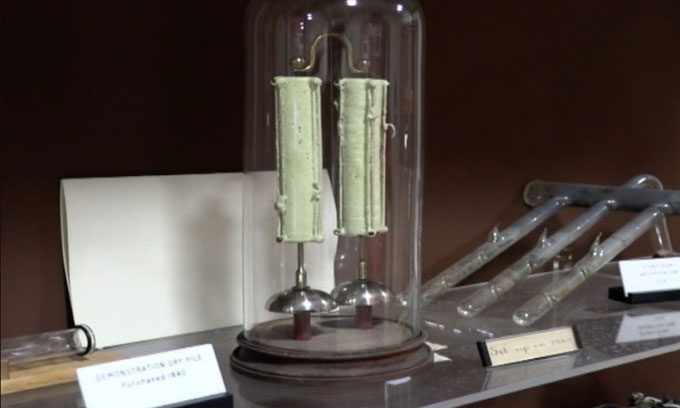An Oxford University battery has made two bells ring continuously for 180 years, yet no one knows exactly why it has lasted so long.
In the mid-19th century, Robert Walker, a physics professor at Oxford University, acquired an intriguing device. It is a battery designed to make a metal sphere oscillate rapidly between two small bells. To this day, the device, known as the Oxford Electric Bell, has been ringing continuously for 180 years since it was produced. Scientists report that the bells have sounded over 10 billion times, according to Smithsonian Magazine.

The Oxford Electric Bell in the Clarendon Laboratory. (Photo: Wikimedia).
Manufactured by Watkins and Hill, a device manufacturing company in London, England, the bell was sent to Walker along with a note stating “Manufactured in 1840.” Today, the bell is displayed at the Clarendon Laboratory at Oxford University. Researchers are still uncertain about the specific mechanism that enables this device, recognized by the Guinness World Records as the “world’s longest-lasting battery,” to function for such an extended period. Disassembling the device for study could potentially ruin it.
The device uses a dry cell battery, one of the earliest types of electric batteries developed by priest and physicist Giuseppe Zamboni in the early 19th century. Dry cells consist of circular discs made of silver, zinc, sulfur, or other materials stacked alternately to produce a low-intensity electric current.
“We don’t know for sure the internal structure of the battery, but the outer layer is sulfur,” said AJ Croft, a researcher who worked at the Clarendon Laboratory, in an article published in 1984 in the European Journal of Physics. “Zamboni created similar battery blocks, consisting of about 2,000 thin sheets glued to paper coated with a zinc-sulfur compound on one side and manganese dioxide on the other.”
The bell does not ring loudly like an alarm clock but produces a very soft sound due to the extremely low voltage of the current passing through. To uncover the mystery of the Oxford Electric Bell, researchers will have to wait until the battery runs out of power or the device deteriorates over time.


















































